
Olivio Barbieri, photography.
“If before the 1970s (roughly speaking) buildings were primarily regarded as (public) expenditure, after the 1970s buildings became mostly a means of revenue – which fact ironically only contributed to further downward pressure on construction budgets. Once discovered as a form of capital, there is no choice for buildings but to operate according to the logic of capital. In that sense there may ultimately be no such thing as Modern or Postmodern architecture, but simply architecture before and after its annexation by capital.”
Rainier de Graaf
“Every generation must build its own city.”
Antonio Sant’Elia
Futurist Manifesto
“Everyday to battle
the weight of increasing dumbness,
insensitivity to new ways;
the joy
— not died — but crushd,
hushd in the dross of repeated
inarticulate scorn.”
Robert Duncan
“It is cruelly intimidating – Lacan writes of ‘the obscene super-ego’ – and it never brings us any news about ourselves. There are only ever two or three things we endlessly accuse ourselves of, and they are all too familiar; a stuck record, as we say, but in both senses – the super-ego is reiterative. It is the stuck record of the past (‘something there badly not wrong’, Beckett’s line from ‘Worstward Ho’, is exactly what it must not say) and it insists on diminishing us. It is, in short, unimaginative; both about morality, and about ourselves. Were we to meet this figure socially, this accusatory character, this internal critic, this unrelenting fault-finder, we would think there was something wrong with him. He would just be boring and cruel. We might think that something terrible had happened to him, that he was living in the aftermath, in the fallout, of some catastrophe. And we would be right.”
Adam Phillips
It is my sense that something very distinct has occurred over the last thirty years. There is no definitive threshold for mapping this societal shift, but the second term of Reagan, which began in 1985 is as good a place as any to chart what was happening. Reagan and Thatcher became the faces of a new erasing of the idea of quality, the erasing of of the idea of compassion, and the acceptance of a new ruthless selfishness. They were, of course, only the logical outcome of larger forces. But it all sort of came together in the mid eighties. With Nixon, there was a florid grand madness, a literal paranoid almost Shakespearean villainy. With Reagan, there was only banality. Naked Imperialist ruling class racist hatred. But somehow it was embodied in the idiotic figure of this former actor.

Adam Cvijanovic (detail: Discovery of America)
The shift in popular culture, that coalesced in the American cinema of the 80s, can be traced back to the late fifties. The end of the post war cinema that featured the great noirs of German emigre directors like Siodmak, Lang, and Wilder and the sincerity of early TV drama, much of it recorded live, had been corporatized. But even through the 1970s there was work financed by studios that still retained a sense of both social criticism and aspirations of something transcendent. The 80s also signaled the perfection of a new model of political hegemony in the U.S. This was the start of a total control of government ‘message’. Marketing had taken over all of electronic media. One need only look at American film, though, to see that by the end of that decade almost nothing heterogeneous was being produced. This decad included two Indian Jones movies, Poltergeist, Top Gun, Terminator, E.T., Pretty in Pink, Goonies, Die Hard, The Karate Kid, Back to the Future, Ghostbusters, and The Breakfast Club. It was the James Cameron, Harold Ramis, and Steven Speilberg decade. This was Reagan’s “New Morning in America” marketed to a pre-fabricated demographic called ‘baby boomers’. It was less the themes of these films, though that bears discussion, but more the aesthetic regression, the loss of craft.
Hilton Kramer’s essay “Postmodern: Art and Culture in the 1980s”, written in 1982, sanctioned the official end of modernism.
“Bourgeois culture, for its part, acquired a finely developed sense of what could be absorbed and what deferred. For this process of selection and adjudication, it created special institutions—museums and exhibition societies, schools, publications, foundations, etc.—which functioned, in effect, as agencies of a licensed opposition.”
Hilton Kramer
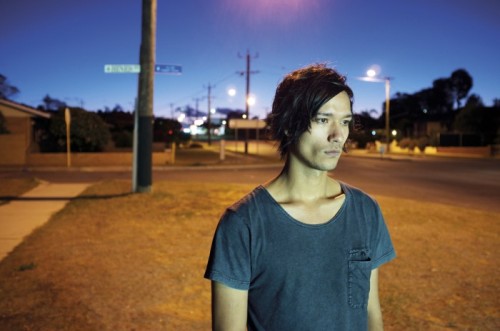
Max Pam, photography.
This may be the most important aspect of this coalescing of culture forces already in play. It expressed something of a new artistic and cultural careerism. This institutionalization of the avant garde had the effect of neutralizing not just opposition, but the idea of opposition. The loss of an avant garde conscience (sincerity) resulted, even in the 80s, in a constant process of cultural excavation. Earlier styles were resurrected, but without context. Earlier styles were bottled and re-sold, not as new, but as a kind of mock authentic nostalgia. Nostalgia which was never called nostalgia.
Quoting Kramer again…
“In the period that saw Andy Warhol emerge as the very model of the new artist-celebrity, moreover, sheer corniness was no longer looked upon as a failure of sensibility, nor was superficiality—or even vulgarity—regarded as a fault. Bad taste might even be taken as a sign of energy and vitality, and “stupid art”—as its champions cheerfully characterized some of the newer styles that began to flourish in the late Seventies and early Eighties—could be cherished for its happy repudiation of cerebration, profundity, and critical stringency. Try to imagine Arshile Gorky or Mark Rothko or Robert Motherwell countenancing such a turnabout in attitudes and you have a vivid sense of the differences separating the last stages of modernist orthodoxy from the very different moral climate of postmodernist art.”
and
“For the purposes of this conversion, no instrument has proved to be more powerful or more pervasive than the attitude of irony we call Camp, which has the effect of neutralizing the substance and aggrandizing the style of whatever it embraces. Irony ridicules, of course, and ridicule normally wounds and discredits. But the ridicule of Camp is a mock ridicule that contains a large element of praise, accommodation, and affection.”
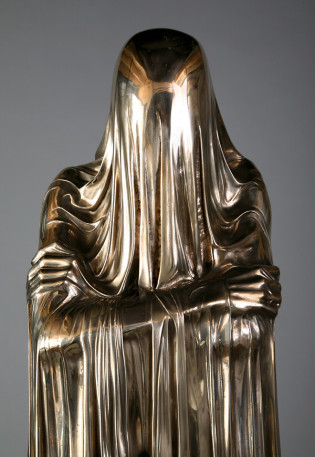
Kevin Francis Gray
Now Kramer rightly points out that the first victim of this new sensibility was *seriousness*. Remember this essay was written in 1982. One of the first effects of the loss of seriousness was that of an in-depth criticism. Not just an aesthetic criticism, but a political one as well. After all, Reagan was a moron, and he was President. Sontag’s essay on ‘Camp’, as Kramer notes, allowed for the pretense of seriousness in discussing junk and kitsch. The collapse of critical standards (per Jencks) paved the way for a corporate manufacture of everything from artworks to architecture to food to clothing. But contemporary society, that of 2015, is in the nether reaches of this cultural and societal shift that began, or solidified, in the 1980s.
“I think of the postmodern attitude as that of a man who loves a very cultivated
woman and knows he cannot say to her, ‘I love you madly’, because he knows
that she knows (and that she knows that he knows) that these words have already
been written by Barbara Cartland. Still there is a solution. He can say, ‘As Barbara
Cartland would put it, I love you madly’. At this point, having avoided false
innocence, having said clearly that it is no longer possible to speak innocently, he
will nevertheless have said what he wanted to say to the woman: that he loves
her; but he loves her in an age of lost innocence.”
Umberto Eco
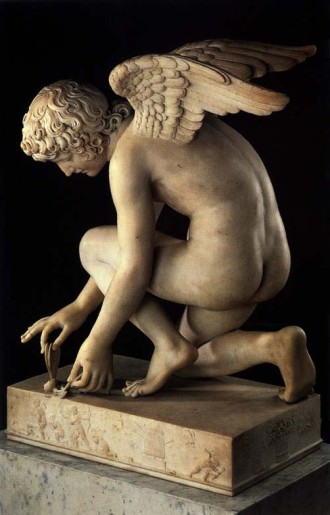
Antoine-Denis Chaudet
Now post modernism was being talked about in the mid 1960s, and was the central topic of the 70s in most journals of architecture and aesthetics. Late capitalism though was increasingly about keeping down cost and maximizing profit. So different things were taking place in architecture than in fine arts or popular art. Still, there is a through line between Phillip Johnson and Peter Eisenman, Warhol, Koons, and James Cameron. And I could easily include, really, George Soros, Bill Gates and Warren Buffet. And the common denominator is in a sensibility of strip mining the human, of rapacious careerism that sees in people little more than a disposable nuisance or the raw material for social advancement. In architecture, Norman Mailer (of all people) called post modern buildings “a landscape of psychosis”. Again, we are thirty years down the road from such observations.
As seriousness got lost, something else got lost with it. When nothing is investigated deeply, or rather, seriously — because you can go deep in a shallow fashion, and that is what I see a lot of. Endless serialization of the trite, in the name of thoroughness. Shallow is never exhausting, so you can do a lot of it. Hobbies are like that. You can collect 14 million candy bay wrappers or beer bottles, which is thorough. Mass production — an automated mass production now — seemed to demand to be replicated. The out of work worker could still have a hobby that imitated work. Instead of turning out Chryslers, beer bottles could be collected, or coasters, or swizzle sticks. So the loss of seriousness also ushered out an idea of maturity. Something else that seems a phenomenon that is quite recent, and that is the appeal of the infantile or childish. One sees it now in political (sic) corporate journalism, but one aimed at a youth market (think Molly Crabapple, FUSION, VICE, et al). The voice of this journalism is uniformally juvenile. The very idea of a ‘youth market’ is actually fairly recent.

Puerta de Europe (KIO Towers). Phillip Johnson, architect. 1989
There is a loss of dignity. Perhaps this is conscious on the part of marketers. The flattering of an ever less educated public with adverts that make sexy an idea of stupidity and narcissism. The proletarian version is seen in beer commercials, for example, where the protagonist of these mini narratives appears always slightly befuddled; the state one might find oneself in after consuming a six pack. But the more pernicious version is the educated white infantile. The spoiled narcissistic twenty something who feels entitled to opinions, who is deserving of being heard regardless of qualifications, or simply by virtue of being cute. This is really not gendered, either. The *cute* trope is found in both young men and young women. In an image of Puer Aeternus. Peter Pan, the beautiful commodity-personage, self aware, at least as regards their own beauty, and it’s market value, but obdurate and petty in all relationships. There is a streak of self pity in this version of petulant Lolita cum Tadzio figure. And such self pity is the projection of guilt, and self hatred and fear.
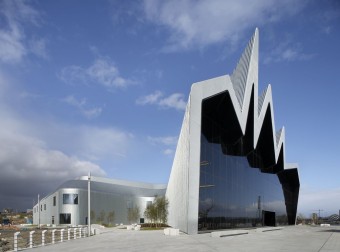
Riverside Museum, Glasgow. Zahia Hadid, architect. 2011.
The voice that seems to have gone missing is the voice of the serious. The public intellectual who is not going to appear on Good Morning America or Late Night with Pol Pot or whomever, Mily Cyrus. I am no longer sure the public can recognize the sound of maturity. For most Americans maturity is either senility, or simply the embalmed plastic celebrity. The horror of plastic surgery is probably only now, in the last few years, becoming obvious. For now those who got procedures done twenty five years ago, are seeing the effects over decades. But I digress. In architecture, if Phillip Johnson was the poster boy for the front edges of post modernism in building, then Zahia Hadid is the legatee some thiry years on. There is precious little difference in their visions, really. Hadid is only making Johnson less serious, and that’s hard to do, really. There are great architects working today; Wang Shu the 2012 Pritzker winner, really is an outlier for his work is so singularly serious. And others of the late 20th century deserve notice; Ludwig Leo for one, and Charles Correa, and Luis Barragan. I probably should appreciate the 2015 Pritzker winner, Frei Otto, more than I do, but I just can’t.
Ludwig Leo though is worth looking at if you don’t know his work. The Berlin based architect (born in Rostock in 1924) was a functionalist, and clearly influenced by Soviet design and Bauhaus. He wrote little and his output is small, but his buildings become more beautiful as they age. Everything was low tech, and that’s another quality that sets him apart. During the war he was badly injured on the Eastern front, and returned home to have his leg amputated. He worked quietly, almost completely in and around Berlin.

T.U. Circulation Tank, 1974. Berlin. Ludwig Leo, architect.
Buro Schwinner writes of Leo:
“He was called a radical functionalist, but that’s true just in the sense that his major ambition was to make the buildings as usable as possible. He was far away from single-use definition of space, things turn into something else, a canteen turns into a lecture hall turns into an operating theatre. He was deeply involved as an architect in the reformation process of the German school system, especially with his study of the Laborschule Bielefeld and the Landschulheim am Solling in Holzminden, but also his competition for the French High School and a school’s gymnasium in Berlin.
Most of his work is an investigation into institutional changes. He’s a Protestant answer to brutalism, in particular James Stirling, and gives different answers to the phenomenons of the time like structuralism, High-Tech, Pop, Neo-constructivism, Rationalism, and the Postmodern.”
His greatest building was the DLRG headquarters (for The Society of German Lifesavers) in Berlin-Spandau. It is, like the Circulation Tank, a construction that defies definition. But never is it alienating. None of his work was.

DLRG Headquarters, Berlin-Spandau. 1967. Ludwig Leo, architect.
Thomas Edlemann wrote of the DLRG:
“The second striking building Ludwig Leo designed, and like the “Umlauftank” it has a unique effect when viewed from afar, was the “Bundeslehr- und Forschungsstätte der DLRG” on the banks of Pichelssee in Berlin’s Spandau district, which was built at almost exactly the same time, namely between 1967 and 1973. The 11-story edifice with a triangular footprint and a stunning 44-degree angle to it served among other things to store lifeboats during winter – they were hauled upwards using a steel system on the west frontage and spread across specific stories. The structure also features teaching rooms with fold-out seating sections in a two-floor hall, a kitchen and cabins for overnighting.”
Ludwig drew his own designs, submitted them in presentations in a manner that was out of time; a man caught in the strange chasm between pre-war modernism, the Cold War, and whatever we call what has come after. Scarred both physically and psychologically, his voice is serious, modest, perhaps a bit melancholy. But for me the DLRG is among the very best of modern architecture. And the T.U tank, aging now, rust creeping in at the corners of the roof, is today more sublime than when it was built. He was an architect of human scale. His buildings became embedded into the communities in which they were built.

Ludwig Leo
The best buildings are narratives. I think it a mistake to deny narrative. It is good to keep in mind, when trying to talk about narrative, the shadow of this encroaching tide of kitsch/camp ethos, which has today (and this is the issue) shed one half of its dynamic — for mass culture today is no longer treated in terms like ‘its so bad its good’; there is simply *entertainment*. And entertainment is broad spectrum, all inclusive and hegemonic. The definition of ‘good entertainment’ is pretty elusive. One can find a number of mainstream publications that will talk about the upcoming summer TV schedule as if they are both discussing the Sistine Chapel, AND simultaneously discussing junk food. It’s the bizarre fusion of both ends of what was once the high/low dichotomy. The Walking Dead or season two of True Detective or Orange is the New Black are evaluated in terms that refer only to previous TV, and to their satisfaction quotient. Except the parameters of that quotient are never examined. And usually popularity is it’s own justification.
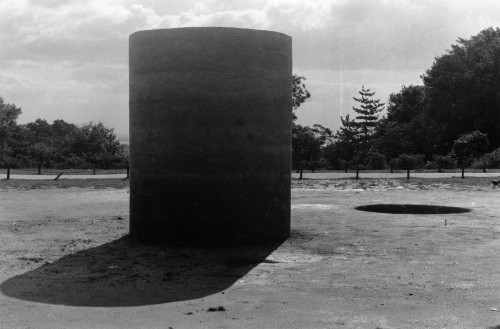
Nobuo Sekine. Kobe, Japan. 1968
“Man’s first attitude toward language was confidence: the sign and the object represented were the same. The sculpture was a double of the model; the ritual formula a reproduction of reality, capable of reengendering it. To speak was to re-create the object alluded to. The exact pronunciation of the magic words was one of the principle conditions of their efficacy. The necessity to preserve the sacred language explains the birth of grammar, in Vedic India.”
Octavio Paz
The reason architecture looms as so primary in most discussions about aesthetics and culture has to do with its linkage of language, at its foundational level, and the social. Architecture is both political and mystical. The evolution of language and text is too complex to delve into here, but there is a sense that societies reach states of transformation or crisis when words lose their meaning. In a wider sense, societies undergo changes or revolutions of some sort when institutions lose their credibility. And credibility is linked to meaning. Paz, actually quotes the famous adage of Confucius who, when asked if here made Emperor what his first act would be. He answered, ‘to rectify the meaning of words’. The word for tragedy, in ancient Greek was meant to imitate the sound of a bleating goat as it was sacrificed. The significance of language is also evident in psychoanalytic theory. The unconscious, said Lacan, was structured like a language. In dreams symbols, images, words, all can have multiple meanings. The society that looks to control and dominate will first look at controlling the meaning of words. But more, it will look to control the usage of words. In contemporary society, that control has been, at least partly, also about eradicating meaning. Not just doing away with individual words, but doing away with a discussion of ‘meaning’. Of devaluing meaning as a concept.
Narrative is always mimetically engaged with, or at least ideally. It is that trigger to memory, to emotional or even epigenetic actions that order how the world is interpreted and felt. Everything is a story. Everything has a grammar. Architecture, then, is engaged with in perhaps the most complex ways of any artform, not least because it is so much more than an artform.
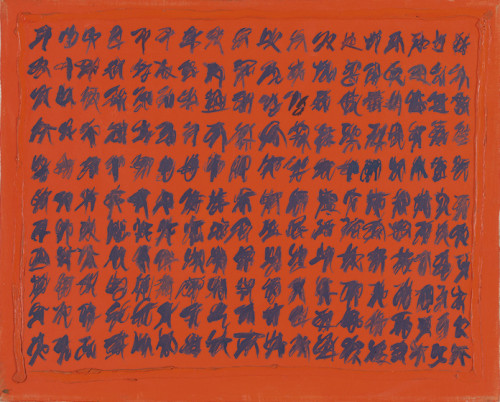
Rolf Gunter Dienst
“It is telling that the most noteworthy architectural manifesto of 1989, the year of the fall of the Berlin Wall and the onset of an uncontested global rule of capitalism, is A Vision of Britain by Prince Charles. The modern age prefigured in ‘The Futurist Manifesto’, at the tail end of the Ottocento with its hereditary hegemonies, ironically concludes with an anti-modern manifesto written by a member of the British Royal Family.”
Rainier de Graaf
At 1 Hyde Park, London, a luxury apartment complex designed by Rogers Stirk Harbour & Partners, is advertised (per de Graaf) as the most exclusive address in the world. Most of the flats (starting at 9 million pounds) are occupied by companies, and only nineteen are occupied as first homes (the majority are listed as second homes, which will illicite a tax break). One can find this phenomenon in most large cities in the U.S. or U.K. Most prestigious architecture firms are no longer even thinking of developing low income housing. And rarely are public buildings designed with anything more than cost in mind. Architecture is capital. The visual grammar of housing today is one in which history is a non-factor. The grammar of exchange value is risk avoidance, not just in material cost, but in ideas. One Hyde Park is the very least imaginative architecture you can find, but no matter, its good investment.

Antonio Sant’Elia
When I try to grasp what I feel has gone missing, regardless of where I start I somehow end up back at books. People don’t read. When I was about sixteen (digression warning) I got a job at the old Pickwick Book store on Hollywood Blvd. It was a wonderful huge three story old building overflowing with books. I loved that job. My boss was an old man named Sidney. He has thick glasses and he had a genuine photographic memory. He never made any of us do too much work, but he wouldn’t tolerate our not knowing books and not helping people who were looking for books. There was not a title that Sidney did not know, nor its publisher, and usually what printing it was in, or if, in fact, it had gone out of print. I stood in the aisles on slow days reading. When I got to New York, at nineteen, I got a job at the Strand. I also loved that job, but not as much because I actually had to work a bit. But I was around book people in New York. We talked books, we bought books, we shared books. We found books exciting. I can barely remember that feeling. I remember there was an academic bookstore downtown somewhere off Cooper Square, at the time. I remember one day finding a copy of a Merleau Ponty title I had been searching for. I was almost deliriously excited. Or another time I had the job of cataloging a part of W.H Auden’s library. Books he had left in his apartment in New York. I was working for an Antiquarian Book store in the Village. Anyway, that was wonderful. I found a number of fascinating history titles. The point is that a certain form of attention comes into play when reading. Not when reading Vogue or Guns & Ammo.
“…adult infantilization, sysematically pursued by today’s cultural industries and resulting in the premature maturation of children and adolescents, whose psychic apparatus has purely and simply been destroyed by the psychotechnical systems of those same cultural industries — this infantilization is being manifested in an unprecedented regression.”
Bernard Stiegler
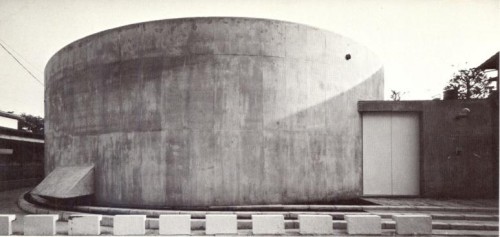
*U* House, Toyo Ito, architect. 1976 Tokyo.
Reading with attention is a kind of meditation; in the sense that consciousness is directed in a way that triggers secondary retentions, and we house these, and access them later. Stiegler suggests the formation of attention is always already both psychic and social. We become individuals by learning, remembering, and storing the actualities of attention. Stiegler notes Foucault’s comment on the occultation of writing in Western society; but that he fails to take this observation to its logical conclusion. And this, I feel, is a critical point. Stiegler writes…“Public use of reason is not that of collective, social, and disciplined action but of individual thought manifested in the process of collective individuation within the critical space of ‘publication’…” What he is getting at is that the individual who has developed a maturity of reason, who has learned through attention, will then be able to articulate critical action with others, a critical public, who engage in some form of shared awareness. Of course this has not existed for a long time on any large scale. But today, there are ever fewer individuals who have not been strip mined of attention, of the ability to think. To absorb criticism — and there is a bit of a paradox here; for even in small communities of people who are working to organize for change, I see the exchange of ideas often succumbing to their own form of emotional obfuscation. Being criticized is less analysed than it is ritualized.

*Towers of Silence*, Parsi burial platform. Edmund Bourne, photography. 1880s. Bombay India.
There is a connection between books and maturity. If architecture is an inscription of memory, of learned signs, and our individual testing and storing of experience in space and with space, then the process of attention, that which came or comes out of this psychic and social network of experience, is going to be reflected in the buildings of sanity, that are mirrors of attentiveness.
With reading comes a maturity and modesty. Even if that sounds sort of corny. All the experiences in the world cannot link one to those voices of the past. And there is in those readings a mirroring of our own primordial formation, our amnesia, and certainly our ambivalence. I am suggesting, I guess, that the ascension of a particularly ruthless super-ego, formed in a narcissistic dynamic, is linked to a lack of maturity — itself the result of atrophied attention (loss of reading) and hence a society of ugly brutal buildings occupied by ever more nasty mean spirited narcissists.
I am at least half serious. Of course the attention I speak of, can be found in non literate societies. Many people who never read are of transcendent awareness. Still, Western society is one that evolved through the Enlightenment, a republic of the written word, the Gutenberg Galaxy. So, the loss of reading is a bit like taking an Eskimo out of his environment and society and making him work as a tele-marketer. His sense of the world would suffer, and he would function almost as if suddenly blind and bi-polar. Contemporary Western white society is one taken out of its history in the republic of letters and sent out into this vast matrix of an information society, one of acute inequality and contradiction. The contradictions may be recognized but somehow elude the conceptual or interpretive grasp of the individual.

Pottery fragment, ink writing. 7th century, Egypt.
Capitalist society privileges productivity, or the appearance of it and sleep was put down as some form of lower animal like behavior. It was unproductive time. Mass culture’s ‘capturing’ of attention has robbed the autonomous creativity involved in pre-modern ideas of reflection and dreaming. Both wakeful dreaming and sleep dreams. The entire society today has lost touch with its dreams. Anxiety is linked to sleep in contemporary society in the West. What am I missing? This anxiety might well extend to spatial perception. The architectural reflection today in the new securitized urban landscape is one of access to information. Not just being able to check your messages, but actual buildings that are themselves always somehow leading the occupant nowhere. But it is a nowhere that provides an illusion of endless data. There is a discussion to be had around the idea of ‘perspective’ today. Remember that Damisch argued the perspective paradigm, in Lacanian terms, was in effect making the vanishing point the plane of projection, and hence the vanishing point becomes the ‘gaze of the other’. Margaret Iversen writes of Damish…“This he {Damisch} thinks is demonstrated by Brunelleschi’s first experiment in perspective, as described by Antonio Manetti, in which he drilled a peep hole through a small wooden panel precisely at the vanishing point of a depiction of the Florence Bapistry so that one could see through it from behind and see an astounding illusionistic depiction reflected in a mirror. Damisch proposes that the vanishing point which is frequently marked in Renaissance painting by a depicted aperture such as a door or window, will from thenceforth have the significance of a look back, of a look that constitutes me as viewer.” Those apertures are looking back. Now this happens, I believe, on stage in another sense when the space off stage is what is returning the gaze and attention (!) of the audience. There is in writing, too, in grammer, and syntax, a form of guiding attention. There are Paleolithic cave art that demonstrate an awareness of perspective. So it was ‘reinvented’. The point though is the implied gaze of the other, the implied imaginary — has perhaps gone missing today. Or, rather, that perspective has become irrelevant. Heidegger did have this concept that man, in his technological world view, sees everything as a form of reserve-ready info. It is there to be ordered and cataloged and that the existential panic comes from a creeping awareness of oneself as part of that reserve-ready body of info.
The anticipation of interruption, as well as that strange very recent lack of ability to track narrative to not just resolution but to anything beyond the most basic first principle in play results in TV shows that begin and it is assumed never end. They are cancelled, or repeated, or continue on in stories that are careful to include their own possible failure to be renewed. Exchange value. The show’s meaning is in its concept. Oh, got it. The watching of the story unfold is secondary. So likewise the new celebrity architect is one creating massive structures that seem to never finally express anything more than ironic acknowledgement that there is nothing lasting or central or even significant in the space they occupy. They are a concept — and nothing more. They deny dream space. They are spaces that prohibit ritual even if advertised as being exactly that. The new mega sports arenas and stadiums are strangely impersonal and anti-community. But perhaps above all else much of this prestige architecture is there to stop you…stop dreams, stop access to the unwanted, stop thought, stop everything. It is a psychic checkpoint architecture.

Allianz Arena, Munich. De Meuron and Herzog architects. 2005.
The idea of lifestyle — marketed as personal freedom of choice — is really a way to maximize control of time. This all echos Jonathan Crary’s excellent book “24/7”. I find that often my favorite artworks and architecture, today, are those that firstly, primarily, create a space, a channel or portal, to the unconscious. Often just that, for that is quite rare.
There was a small moment in one of the last episodes of Mad Men (which has not ended). It was a remarkable and moving scene. The ghost of Bertram Cooper (Robert Morse) appears besides Don Draper, while driving at night, otherwise alone. Cooper quotes Jack Kerouac..
“Whither goest thou, America, in thy shiny car at night?”
That was great stuff. So, it does sometimes happen.
We live in a landscape in which the militarism of the state often passes unnoticed. Orientation is fractured. The infantile narcissists must blind themselves to the omnipresent surveillance, and worse, to the reality of a society that is beginning to physically reflect its own undifferentiated psychosis. Crary says…“it is like a state of emergency, when a bank of floodlights are suddenly switched on in the middle of the night, seemingly as a response to some extreme circumstances, but which never get turned off…”. The public now routinely accepts the infinite tasks it is given to prove their right to exist. There is literally less and less space for the kind of attention that allows maturation. There is no room to be adult.
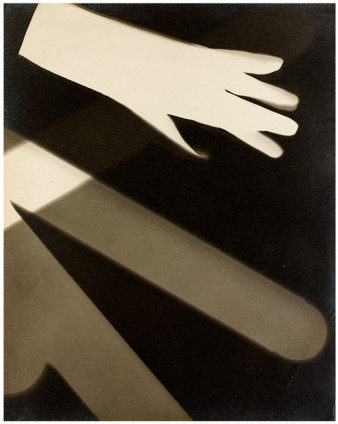
Curtis Moffat, photography. 1925
“As I sd to my
friend, because I am
always talking,—John, I
sd, which was not his
name, the darkness sur-
rounds us, what
can we do against
it, or else, shall we &
why not, buy a goddamn big car,
drive, he sd, for
christ’s sake, look
out where yr going.
Robert Creely
‘I Know a Man’

John,
We have not met. David Van Asselt gave me a play of yours. Thanks for this post. Fucking great. Now I have to read your play. I am going to send this to some folks that need this if that is okay?
Brian
ah hello Brian.
Yes of course. Good to meet you and thanks./
http://www.salon.com/2014/04/13/david_foster_wallace_was_right_irony_is_ruining_our_culture/
Alex, that article was like a mermaid — first half beautiful, second half seriously fishy. He makes good points about sincerity, the loss thereof, and about a reconsideration of aesthetic values, but then goes on to offer some of the worst and most inane practical criticism I’ve ever seen.
definitely right about that … one of those classic scenarios where the writer’s strengths are in diagnostics … not treatment.
John:
I’m curious. Why in your view would you say that contemporary literary culture is so reactionary, or at least primarily governed by Curtis White’s “the middle mind” in the sense that anything with the sheen of prestige is given the benefit of the doubt? Whether it’s Franzen or Toni Morrison or Dostoevsky or Virginia Woolf it doesn’t matter, it’s all the same, it’s all respectable literature. I don’t understand why this “W.H. Smith” ethos is so pervasive in the culture of letters. Now in certain circles, if I call it out on such grounds I’ll often get dismissed as some “trendy nihilist”. Even cinephile and audiophile communities aren’t nearly this bad. I could be wrong, but I sense you specifically John would find someone like Harold Bloom to be a more pernicious influence than even Roger Ebert, in spite of the fact the latter had middlebrow predilections of his own.
A serious-minded aspiring artist these days probably has a better chance of making a living as a musician or as a filmmaker than as a novelist these days, and people like Bernard-Stiegler really only make their living by teaching.
But I also think *seriousness* itself can become an easily exploitable crutch for artists craving respect and prestige. See Michael Haneke or the Andrew Sarris category *strained seriousness*.